Nov 03, 2025
Nov 03, 2025
The spread of the Upanishads to the West took centuries. Sanskrit was truly a foreign language for most scholars in Europe, and the Upanishads were practically unknown to Europe until the 17th century. Persian on the other hand was a prevailing language and many scholars in Europe were well suited to understand this prominent language of the East of the time. Many Indians are unaware that it was a Persian translation of the Upanishads that first exposed the west by making it available in a language many were proficient in. This was the translation undertaken by the long forgotten Mughal Prince Dara Shikoh in the year 1657.
A Frenchman again translated Dara Shikoh's Persian translations into Latin, one hundred years later. It was this Latin translation that stoked the interest of Europeans in ancient Indian cultures. The German philosopher Schopenhauer was an admirer of the Upanishads after he read a Latin translation of Dara Shikoh's Persian version. There were other European poets and philosophers in the eighteenth and nineteenth century who were enamored by Upanishads so much that it reflected on their writings and poems. American poets Ralph W Emerson, Walt Whitman and Henry David Thoreau were transcendentalists, who laid the groundwork for the acceptance of Upanishads in America prior to the arrival of charismatic Swami Vivekananda in 1893. Many of their poems were influenced by teachings of Upanishads.
The British, especially the founders of the Asiatic Society, undertook many works on Indic studies in the nineteenth century, with the encouragement of the Governor General Warren Hastings of East India Company. Earlier Americans in Boston had formed American Oriental Society.
Archaic and Classical Greece
- which way did the information flow?
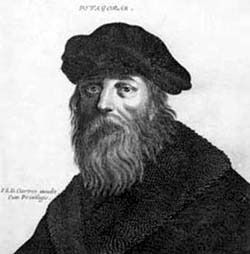 It is generally believed that after the arrival of Alexander the Great in 326 B.C.E., the gates of India were laid open for Greek influence. It is partly true but the direction of knowledge might have flown the other way from East to West. Pythagoras (580/572-500/490 B.C.E), centuries earlier might have had contact with Indian Vedantis. His best known theory of mathematics, namely the Pythagorean theorem was already known in India, and his theory of harmony of spheres reflect the esoteric use of numbers in the Vedas and Upanishads. But Pythagoras is credited to have provided irrefutable proof for the theorem.
It is generally believed that after the arrival of Alexander the Great in 326 B.C.E., the gates of India were laid open for Greek influence. It is partly true but the direction of knowledge might have flown the other way from East to West. Pythagoras (580/572-500/490 B.C.E), centuries earlier might have had contact with Indian Vedantis. His best known theory of mathematics, namely the Pythagorean theorem was already known in India, and his theory of harmony of spheres reflect the esoteric use of numbers in the Vedas and Upanishads. But Pythagoras is credited to have provided irrefutable proof for the theorem.
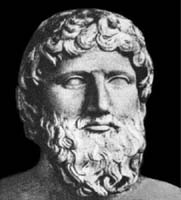 But it is in the writings of Plato (429-347 B.C.E.) the influence of Upanishads is more discernible. His ?allegory of the cave? is reminiscent of the theory of illusion (maya) so well described in the Upanishads. Both Pythagoras and Plato believed in the immortality of the soul (atman) and reincarnation. Aristotle (384-322 B.C.E.), Plato's student and teacher of Alexander, held similar thoughts. Max Muller, who translated the Upanishads, was indeed shocked to see the similarities of Plato's writings and the Upanishads.
But it is in the writings of Plato (429-347 B.C.E.) the influence of Upanishads is more discernible. His ?allegory of the cave? is reminiscent of the theory of illusion (maya) so well described in the Upanishads. Both Pythagoras and Plato believed in the immortality of the soul (atman) and reincarnation. Aristotle (384-322 B.C.E.), Plato's student and teacher of Alexander, held similar thoughts. Max Muller, who translated the Upanishads, was indeed shocked to see the similarities of Plato's writings and the Upanishads.
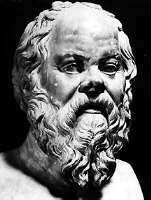 The Upanishads also influenced Plato's predecessor and mentor Socrates (469-399 B.C.E.) as well. He was reputed to have met an Indian philosopher while roaming the streets of Athens. Socrates learned from the Indian the relationship between the Absolute (Divine) and the relative (the human). Most of these Greek philosophers also believed in reincarnation, the idea that most certainly came from the East. Socrates said, "I am confident that there truly is such a thing as living again, and the living spring from the dead."
The Upanishads also influenced Plato's predecessor and mentor Socrates (469-399 B.C.E.) as well. He was reputed to have met an Indian philosopher while roaming the streets of Athens. Socrates learned from the Indian the relationship between the Absolute (Divine) and the relative (the human). Most of these Greek philosophers also believed in reincarnation, the idea that most certainly came from the East. Socrates said, "I am confident that there truly is such a thing as living again, and the living spring from the dead."
To understand humans, an understanding of the Absolute is necessary - a fundamental teaching of the Upanishads. Author E. J. Urwick on his interpretation of Plato's Republic, weaves together Socratic-Platonic teachings and classical Indian concepts.
Dara Shikoh's Contribution:
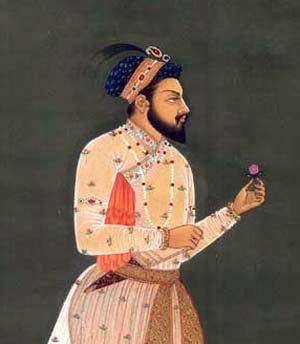 Europeans got a taste of Indian classical teachings long before Max Muller and others translated the tenets into European languages in the 19th century. It was the Persian translation undertaken by Prince Dara Shikoh, eldest son of Emperor Shah Jahan. Dara Shikoh was first exposed to the Upanishads while in Kashmir in the summer of 1640. The Prince, in the mold of his grandfather Akbar (who also had reputedly translated Upanishads, which have been lost), had openly professed liberal religious thought and even had penned a book on reconciliation and integration of the religions of Hindus and Islam. While he thought that few Indians were well versed with Upanishads, he also was of the belief that the wisdom of the monotheistic truth was deliberately kept a secret from Muslims by the establishment. Dara Shikoh invited many pundits from Benares to Delhi, who assisted him in translating 50 Upanishads into Persian language. The translation, the Upanekhats, took about two years and was completed in 1657, the same year the Emperor Shah Jahan fell ill and frenzy over succession was to develop amongst the four brothers, all sons of the Emperor. The last sibling Aurangzeb eventually disposed off all his brothers and ascended the throne in 1658, putting his father in house arrest. In the year 1659 Dara Shikoh, the rightful heir, who had fled to Lahore was captured by Aurangzeb, and unceremoniously paraded in the streets of Delhi in chains. Later his body was cut into pieces and again paraded on the same streets, an inglorious end to an enlightened Prince. The extremely orthodox Aurangzeb accused him of being an infidel and a danger to the religion of Islam.
Europeans got a taste of Indian classical teachings long before Max Muller and others translated the tenets into European languages in the 19th century. It was the Persian translation undertaken by Prince Dara Shikoh, eldest son of Emperor Shah Jahan. Dara Shikoh was first exposed to the Upanishads while in Kashmir in the summer of 1640. The Prince, in the mold of his grandfather Akbar (who also had reputedly translated Upanishads, which have been lost), had openly professed liberal religious thought and even had penned a book on reconciliation and integration of the religions of Hindus and Islam. While he thought that few Indians were well versed with Upanishads, he also was of the belief that the wisdom of the monotheistic truth was deliberately kept a secret from Muslims by the establishment. Dara Shikoh invited many pundits from Benares to Delhi, who assisted him in translating 50 Upanishads into Persian language. The translation, the Upanekhats, took about two years and was completed in 1657, the same year the Emperor Shah Jahan fell ill and frenzy over succession was to develop amongst the four brothers, all sons of the Emperor. The last sibling Aurangzeb eventually disposed off all his brothers and ascended the throne in 1658, putting his father in house arrest. In the year 1659 Dara Shikoh, the rightful heir, who had fled to Lahore was captured by Aurangzeb, and unceremoniously paraded in the streets of Delhi in chains. Later his body was cut into pieces and again paraded on the same streets, an inglorious end to an enlightened Prince. The extremely orthodox Aurangzeb accused him of being an infidel and a danger to the religion of Islam.
Dara Shikoh's unmarked grave lies in the open sun in the outer courtyard of Humayun's tomb in Delhi. But his contribution, the Persian translation of the Upanishads survived, and a copy was brought to France by the traveler Francois Bernier (who incidentally stayed in India for twelve years, and acted as a personal physician to Emperor Aurangzeb). There were many prominent European scholars who were proficient in Persian, the most widely used language of the East. Once the Persian version reached Europe, the entire continent was potentially open to the wisdom of the Upanishads, yet it remained un-translated to any of the European languages for another century.
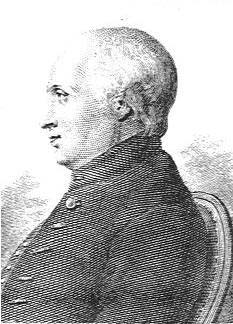 Anquetil-Duperron's Latin Translations:
Anquetil-Duperron's Latin Translations:
The Oupnek'hat
It was not until the year 1775, that Dara Shikoh's Persian translation attracted any attention from European scholars. Abraham Hyacinth Anquetil-Duperron (1731-1805), an Orientalist who had already translated the Persian version of Zend-Avesta, undertook the task of translating Dara Shikoh's Upanishads into Latin. He translated it into French as well but this was never published. The Latin translation called Oupnek'hat was published in 1801 and 1802. The translation however was not well written and was mere gibberish to the un-initiated. Nevertheless, this became the framework for the German philosopher Schopenhauer (1788-1860), who discovered the thread of sanity through the labyrinth of unintelligible jargon written by Anquetil-Duperron. Oupnek'hat also became the basis on which many more Europeans could now dwell into the study of Upanishads.
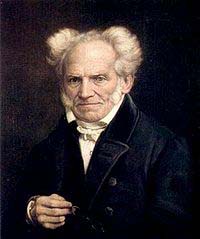 Schopenhauer did not doubt the authenticity of Oupnek'hat, as translated by Anquetil-Duperron. Dara Shikoh had retained many Sanskrit words intact and un-translated. Anquetil-Duperron also left those words and other Persian syntaxes intact, but explained them in a glossary. Chandogya Upanishad formed the basis of Schopenhauer's work World of Will and Representation.
Schopenhauer did not doubt the authenticity of Oupnek'hat, as translated by Anquetil-Duperron. Dara Shikoh had retained many Sanskrit words intact and un-translated. Anquetil-Duperron also left those words and other Persian syntaxes intact, but explained them in a glossary. Chandogya Upanishad formed the basis of Schopenhauer's work World of Will and Representation.
"The Upanishads are the production of the highest human wisdom and I consider them almost superhuman in conception. The study of the Upanishads has been a source of great inspiration and means of comfort to my soul. From every sentence of the Upanishads deep, original and sublime thoughts arise, and the whole is pervaded by a high and holy and earnest spirit. In the whole world there is no study so beneficial and so elevating as that of the Upanishads. The Upanishads have been the solace of my life and will be the solace of my death," wrote Schopenhauer. He made no secret of the fact that his foundation of philosophy was mostly based in the tenets of the Upanishads. His exuberance on praising the wisdom of the Upanishads was so complete he had no doubt that "the native pantheism of India, which is destined sooner or later to become the faith of the people. Ex oriente lux. (Light of the East)"
Schopenhauer also predicted that Christianity would never take root in India in a substantial way. "The primitive wisdom of the human race will never be pushed aside by the events of Galilee. On the contrary, Indian wisdom will flow back upon Europe, and produce a thorough change in our knowing and thinking," he wrote. Whether this prediction will bear any fruit is a question of conjecture, but it is now generally accepted that Upanishads impart a kind of knowledge that is universal and applicable to any modern religion.
Another 19th century French philosopher who also had written two chapters of Bhagavad-Gita in his writing said, "When we read with attention the poetical and philosophical monuments. ..of India,. ..we discover there so many truths, and truths so profound, and which make such a contrast with the meanness of the results at which the European genius has sometimes stopped, that we are constrain- led to bend the knee before that of the East, and to see in this cradle of the human race the native land of the highest philosophy."
Role of Germany and England
The Indian philosophical thought when poorly understood by the Western philosophers was invariably branded as Indian mysticism. However Schopenhauer cannot be blamed for such tendencies. He was thoroughly honest in his thinking as well as in his speech, and had been totally influenced by the texts of the Upanishads.
Other German philosophers like Friedrich Schelling (1775-1854), and Max Muller (1823-1900) were influenced by the Upanishads. Schelling and his school had used even more rapturous language in describing the Upanishads than Schopenhauer, and his student and apprentice Friedrich Max Muller (1823-1900) was encouraged to translate the Upanishads.
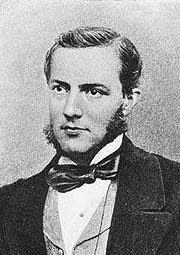 Max Muller worked on the science of languages and its relationship with science of religions.
Max Muller worked on the science of languages and its relationship with science of religions.
Muller moved to England to study Sanskrit and was eventually given access to Sanskrit texts in the possession of East India Company. He found employment in Oxford and spent several years in the faculty. Here he became the leading intellectual commentator on the culture of India. Muller thought that to study a language or a religion one needs to go to the oldest texts, which tend to retain their originality and culture in an unadulterated form. Thus his keen interest in Rig Veda. Muller went on to become the premier Orientalist and philologist of his time in Europe.
Max Muller?' successor Paul Deussen (1854-1919) said, "The Vedanta is, now as in the ancient time, living in the mind and heart of every thoughtful Hindu This fact may be for poor India in so many misfortunes a great consolation; for the eternal interests are higher than the temporary; and the system of the Vedanta, as founded on the Upanishads and Vedanta-sutras and accomplished by Sankara's commentaries on them, equal in rank to Plato and Kant is one of the most valuable products of the genius of man- kind in its search for the eternal truth." He also said, "On the tree of wisdom there is no fairer flower than Upanishads and no finer fruit than the Vedanta philosophy."
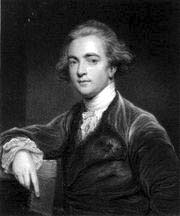 In the eighteenth century philologist Sir William Jones (1746-1794) first proposed that Sanskrit might be related to Greek and Latin and perhaps even to Gothic and Celtic languages. This elicited a keen interest in Europe about the ancient Indian language of Sanskrit. Here is his most famous quote about the relationship of these languages:
In the eighteenth century philologist Sir William Jones (1746-1794) first proposed that Sanskrit might be related to Greek and Latin and perhaps even to Gothic and Celtic languages. This elicited a keen interest in Europe about the ancient Indian language of Sanskrit. Here is his most famous quote about the relationship of these languages:
"The Sanscrit language, whatever be its antiquity, is of a wonderful structure; more perfect than the Greek, more copious than the Latin, and more exquisitely refined than either, yet bearing to both of them a stronger affinity, both in the roots of verbs and the forms of grammar, than could possibly have been produced by accident; so strong indeed, that no philologer could examine them all three, without believing them to have sprung from some common source, which, perhaps, no longer exists; there is a similar reason, though not quite so forcible, for supposing that both the Gothic and the Celtic, though blended with a very different idiom, had the same origin with the Sanscrit; and the old Persian might be added to the same family."
Sir William Jones also founded the Asiatic Society, which further launched the study of Indian culture, never before understood by the westerners. Sir Jones unfortunately died at the young age of forty-seven in Calcutta.
Another member of the Asiatic Society in 1784, Sir Charles Wilkins translated Bhagavad-Gita into English in 1785, which opened entire Europe to that ancient Indian text. Sir Wilkins had also translated portions of Mahabharata (never completed) and these were also published. (This inspired William Blake to create his work called The Brahmin, showing Sir Wilkins learning Sanskrit from the Brahmin pundit Kalinatha in India).
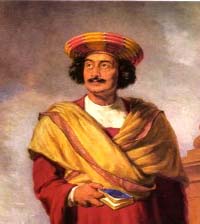 A prominent Indian, who was also a reformer, took interest in the Upanishads. Though Raja Rammohun Roy (1774-1833) shunned all the ritualism and idolatry of Hinduism, he was fascinated by the knowledge imparted by the Vedanta. He was the founder of Brahmo Samaj but was accused of being a crypto- Christian because of his unabashed belief in the divinity of Christ. He had rejected the puranas, the Laws of Manu and even the sanctity of the Vedas. But he could equate the Upanishads to true Christianity and he could not reject them. He subsequently translated the Upanishads into Bengali, Hindi and English and published them at his own personal cost. Muller was an admirer of Rammohun Roy and had frequent contacts with Brahmo Samaj.
A prominent Indian, who was also a reformer, took interest in the Upanishads. Though Raja Rammohun Roy (1774-1833) shunned all the ritualism and idolatry of Hinduism, he was fascinated by the knowledge imparted by the Vedanta. He was the founder of Brahmo Samaj but was accused of being a crypto- Christian because of his unabashed belief in the divinity of Christ. He had rejected the puranas, the Laws of Manu and even the sanctity of the Vedas. But he could equate the Upanishads to true Christianity and he could not reject them. He subsequently translated the Upanishads into Bengali, Hindi and English and published them at his own personal cost. Muller was an admirer of Rammohun Roy and had frequent contacts with Brahmo Samaj.
Effects of Vedanta On America
Prior to Vivekananda's (in 1893) visit to America to speak at the Parliament of Religions in Chicago, Upanishads had influenced several American transcendentalist poets.
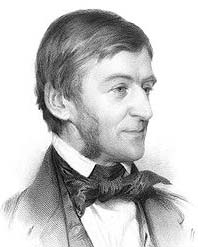 Ralph Emerson (1802-1823) had received a copy of Sir Wilkins' English translation of the Bhagavad-Gita. His poems Celestial Love, Woodnotes and Brahma describe nature and immanent God, akin to that seen in the Upanishads. Katha Upanishad influenced Emerson and he embraced the principle of the Supreme Being (parama-atman). "Soul is not born" he wrote, "it does not die; it was not produced from anyone; Unborn, eternal, it is not slain, though the body is slain." He was a believer in the immortality of the soul and in reincarnation. Emerson wrote, "It is a secret of the world that all things subsist and do not die, but only retire a little from sight and afterwards return again - Nothing is dead; men feign themselves dead, and endure mock funerals and mournful obituaries, and there they stand looking out of the window, sound and well, in some new and strange disguise."
Ralph Emerson (1802-1823) had received a copy of Sir Wilkins' English translation of the Bhagavad-Gita. His poems Celestial Love, Woodnotes and Brahma describe nature and immanent God, akin to that seen in the Upanishads. Katha Upanishad influenced Emerson and he embraced the principle of the Supreme Being (parama-atman). "Soul is not born" he wrote, "it does not die; it was not produced from anyone; Unborn, eternal, it is not slain, though the body is slain." He was a believer in the immortality of the soul and in reincarnation. Emerson wrote, "It is a secret of the world that all things subsist and do not die, but only retire a little from sight and afterwards return again - Nothing is dead; men feign themselves dead, and endure mock funerals and mournful obituaries, and there they stand looking out of the window, sound and well, in some new and strange disguise."
Emerson's poem Brahma, wherein he extols the parama-atman, the cause and result all things as well as the strength and weakness all that is living or inert, is a classic.
Brahma
If the red slayer think he slays,
Or if the slain think he is slain,
They know not well the subtle ways
I keep, and pass, and turn again.
Far or forgot to me is near;
Shadow and sunlight are the same;
The vanished goods to me appear;
And one to me are the shame and fame.
They reckon ill who leave me out;
When me they fly, I am the wings;
I am the doubter and the doubt,
And I the hymn of the Brahmin sings.
The strong gods pine for my abode,
And pine in vain the sacred Seven;
But thou, meek lover of the good!
Find me, and turn thy back on heaven.
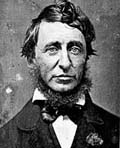 Henry David Thoreau (1817-1862) acknowledged that Vedas were the chief instruments in his quest for acquiring knowledge.
Henry David Thoreau (1817-1862) acknowledged that Vedas were the chief instruments in his quest for acquiring knowledge.
He said, "What extracts from the Vedas I have read fall on me like alight of a higher and purer luminary."
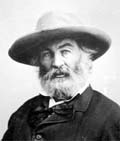 Walt Whitman (1819-1892) was also deeply influenced by Upanishads as evidenced by his compositions of Leaves of Grass, wherein he expresses his knowledge of the Vedas, especially in his acknowledgement of immanence of God and ability to intuit knowledge.
Walt Whitman (1819-1892) was also deeply influenced by Upanishads as evidenced by his compositions of Leaves of Grass, wherein he expresses his knowledge of the Vedas, especially in his acknowledgement of immanence of God and ability to intuit knowledge.
Whitman in his poem Song of Myself wrote:
I know I am deathless
We have thus far exhausted
Trillions of winters and summers,
There are trillions ahead, and
Trillions ahead of them.
But even before the transcendentalists, at least one American president, John Adams had read extensively Hindu religious texts (most probably the Upanishads). He was in correspondence with his friend Thomas Jefferson until the day of both of their deaths on the same day (July 4, 1826). In one of his letters to the sage of Monticello, Adams wrote, "After revolting against the Supreme Being, some souls were hurled down to the regions of total darkness. They were then released from prison, permitted to ascend to earth and migrate into all sorts of animals, reptiles, birds, beasts and men, according to their rank and character, and even into vegetables, and minerals, there to serve on probation. If they have passed without reproach their several graduations, they were permitted to become cows and men. If as men they behaved well, they were restored to their original rank and bliss in Heaven" Where else could John Adams have gathered this knowledge but from the Upanishads? Benjamin Franklin also believed in reincarnation as a plausible explanation and wrote, "Finding myself to exist in the world, I believe I shall in some shape or other, always exist."
While the British were getting interested in ancient Indian culture during the latter half of nineteenth century, the Americans were not to be left behind. In 1853 American Oriental Society was formed in Boston, and through Harvard Oriental Series (started in 1891) Indian studies were conducted, making much of the ancient Indian wisdom available to ordinary Americans.
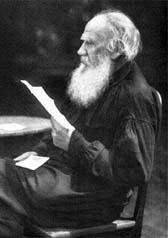 Even the Russians were interested early on, from the time when Oupnek'hat became available. Leo Tolstoy (1828-1910) showed much interest in the Upanishads and the Bhagavad-Gita. His letter to Mohandas Gandhi published in Free
Even the Russians were interested early on, from the time when Oupnek'hat became available. Leo Tolstoy (1828-1910) showed much interest in the Upanishads and the Bhagavad-Gita. His letter to Mohandas Gandhi published in Free
Hindustan, as "A Letter to a Hindu" is full of Vedantic principles and quotes. Tolstoy was a fan of Swami Vivekananda and had read his writings. Tolstoy also wrote, "As we live through thousands of dreams in our present life, so is our present life only one of many thousands of such lives which we enter from the other, more real life and then return after death. Our life is but one of the dreams of that more real life, and so it is endlessly, until the very last one, the very real life - the life of God."
In the Modern Era
Of course, Swami Vivekananda, who in his brief life of thirty-nine years, established many Vedanta Societies in the west as well as Ramakrishna Missions set the stage for propagation of Vedic ideas in the west and in India for perpetuity.
In the modern era the Upanishads attracted many more poets and philosophers. Artist Paul Gauguin wrote about karma as degrading or elevating according to merit or demerit. He also strongly believed that sages of ancient India had taught Pythagoras.
James Joyce turned to reincarnation repeatedly in his book Ulysses. In Jack London's novel The Star Rover, the main character says, "I did not begin when I was born, or when I was conceived I have been growing, developing through incalculable myriads of millenniums - all my previous selves have their voices, echoes, promptings in me - Oh, incalculable times again shall I be born, and yet the stupid dolts about me think that by stretching my neck with a rope they will make me cease."
Herman Hesse in his novel Siddhartha dealt with Vedantic ideas extensively. Richard Bach in his novel Jonathan Livingston Seagull described "that brilliant little fire that burns within us all, goes through a series of reincarnations that lead him from earth to a heavenly world and back again, to enlighten the less fortunate gulls."
Nobel laureate Isaac Bashevis Singer discusses the immortality of the soul in his short stories. "There is no death. How can there be death if everything is part of the Godhead? The soul never dies and the body is never really alive." British poet laureate John Masefield in his poem about past and future lives writes:
I hold that when a person dies
His soul returns again to earth;
Arrayed in some new flesh disguise,
Another mother gives him birth
With sturdier limbs and brighter brain
The old soul takes the road again.
In the early 20th century, another French traditionalist Rene Guenon published Eastern metaphysical doctrines of Hinduism mainly based on Vedanta. Through his recognition of Vedanta alone as Hinduism, he was criticized for not recognizing other darshana literatures or the Brahma-sutra as integral part of Hinduism. Vedanta and Upanishads had been so widely accepted by this time in the West that other aspects of the practice of Hinduism and its expression (except for Bhagavad-Gita) had been ignored as practices modified by a religion over time.
Nevertheless Upanishads, in a span of just over two hundred years since it reached the west, have inspired many learned men to think radically differently from what their own established religions had taught them. The concept of soul and the Supreme Being, as well as reincarnation and the doctrine of karma caught the attention and the fascination of many western philosophers and poets.
15-Mar-2009
More by : Dr. Neria H. Hebbar

|
Reading this well researched article in 2025 is really a wonder to behold. Being a voracious reader , I am really blessed to have ventured into reading literary articles. I would like to go through H V Viswesaran's blog. |

|
An illuminating and enlightening article. Upanishads are the splendors of the unseen. Thanks for sharing. |

|
good article |

|
Extremely nice article.. I am deeply rooted Upanishads, Vedanta, Plato and Kant..While searching Indian influence on Western thought I found your Article.. I am very much impressed by the Persian Translation of the Upanishads.. I love Persian Sufism too. Thank you so much. we can establish a Center for Intercultural studies to explore these deeper messages and sublime experiences with all the richness of our Asian culture. |

|
Marvelous article, great information. |

|
How Upanishads Influenced the thinking of scholars worldwide is nice reading. I want to append this article with my, an Indian Tamililian, views ( www.philosophyofkuralta.blogspot.in ) of how the Tamil classic influenced Bagavadgita, an epitome of Upanishads. Due to the long discussion involved I have given my blog URL. I wish those interested to go through my blog and comment. H.V.VISWESWARAN |

|
really awesome article |

|
Very enlightening article and well researched too. |